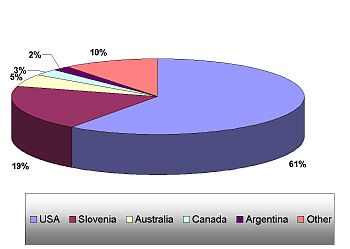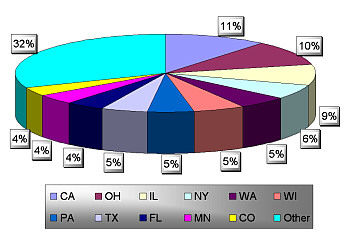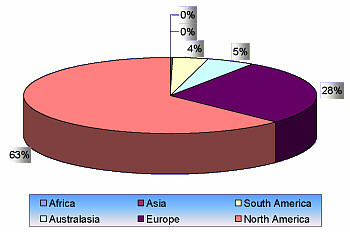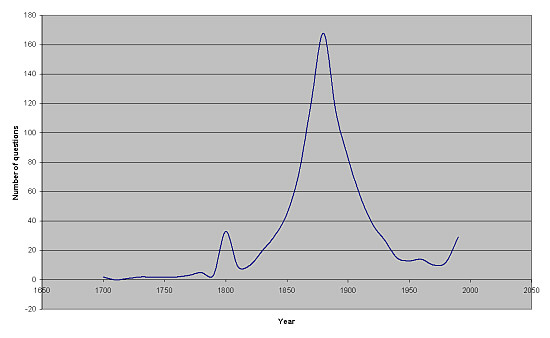Six years of Genealogy and Heraldry in SloveniaFebruary 2005 by TomaŽ Pisanski In 1995, we had configured an Internet server in order to support genealogy and heraldry in Slovenia. In this article, I will describe some of its features, provide some statistics and discuss plans for its modernisation. The main drawback of the server is its ongoing maintenance and that it should be upgraded from a voluntary to a semi-professional level. This issue highlights financial issues facing genealogy and heraldry related research in Slovenia. In the Summer of 1995 we set up at the Institute of Mathematics, Physics and Mechanics of the University of Ljubljana, an internet server at genealogy.ijp.si that we named "Genealogy and Heraldry in Slovenia", dedicated to genealogy and heraldry studies and research related to Slovenia. We wanted to explore the power and capabilities of new technology that was becoming readily available by the advent of the Internet. Our vision was to take advantage of the emerging Internet paradigm of globally available and accessible information and data exchange that is of great advantage to anyone interested in genealogy.
When computer programs specialized to genealogy became available, it became possible for a layman to handle genealogical databases containing several thousand individuals with no particular effort nor special skills, a capability that was quite unimaginable only 50 years ago. More and more people requested more and more genealogical data. Tracing back ancestors and relatives through various lineages necessarily lead to geographically dispersed sources of information. Without the Internet, such research would be in reach to only the researchers with the financial resources to pursue such data. However, the Internet changed it all. It is now possible to gather data from distant places while staying in the comfort of one's home. Instead of authoring information, we wanted to set up a system that would gather and edit information provided by users of the system. Our goal was not to duplicate the work of others. We did not want to make bad copies of good originals but rather provide links directing users to the pristine sources of information by providing appropriate links, and to provide genealogy oriented interface in some cases. An example of such a link is the telephone directory of Slovenia. Combined with a detailed map of Slovenia, it is an excellent source of names and places in Slovenia. It is very useful for genealogical research of those outside Slovenia who would like to localize the birthplace of some of their ancestors or establish contacts with their living relations in Slovenia. There are many other similar links possible, but they would require a more user-friendly interface. Although we have all necessary knowledge for providing such an interface, it would require significant financial support or investment.
However, the main advantage of the Internet is its capability of generating synergetic effects for distributed interested individuals sharing common specialized interests. Our site is intended for a growing group of users with interests along three topics: genealogy, Slovenia and heraldry. Due to strong emigration of Slovenians in the past two hundred years, the need for a Slovenia based genealogical site with an international flavor became a necessity. When we started our endeavor, we were aware of risks of fatigue and eventual failure. Organization and maintenance of such a site requires a lot of work and would require at least one part-time position. On the other hand we were aware that no one is going to support such a risky enterprise with no clear benefits. After six years of Genealogy and Heraldry in Slovenia it is perhaps time to look back and analyze the site. In this article, we will concentrate only on the contributions that our users made to the site and leave further analysis for some other occasion.
Under the guidance of Professor Vladimir Batagelj, his graduate student Matjaž Zaveršnik developed a programming tool, called TRUBAR that builds a database with an Internet interface accessible by any browser. TRUBAR and its predecessor GBOOK (guest-book) were used immediately at several places of our site. Initially we wanted to set-up a guest-book where users would communicate with us and help us improve the system. On August 23, 1995, I posted the first entry: "This is the place for Questions, Answers and Comments about Genealogy and Heraldry in Slovenia." This subsystem evolved into the so-called "Q&A column". We wanted to have both questions and answers mostly from our users. Although the questions are posted quite frequently, the answers are almost absent. Unfortunately, the answers are not necessarily recorded since they are frequently mailed directly to the person posing the question. In the first years our interventions were quite frequent but have recently dropped down almost to zero due to lack of time and plans to reorganize the site. The other system where TRUBAR is used is called "Name Database" and needs almost no administrator intervention. It was established when it became obvious that the Q&A column was used for genealogical research. Most entries contained names, dates and places. The Name database is specialized and focused on surnames. There is a need for several improvements that are waiting for the time when we will find enough time and energy to reorganize the site. Since TRUBAR does not allow users to delete or modify their entries, we are thinking of replacing it with a professional tool, one of those that are now available and are much more powerful than TRUBAR.
We checked the addresses of all users of the Q&A column posting questions from August 1995 - September 2001. The following table represents the number of entries by the country. It is perhaps surprising, that countries that share a border with Slovenia have very low score: Austria (8), Croatia (4), Italy (3), Hungary (0). This can be partially explained by a language barrier. Most questions come from English speaking countries. It seems that the Q&A column serves best those who are located very far from Slovenia. It can be seen that more than half of our users come from the USA.
Due to the large proportion of the entries originating from the USA, we included the analysis of the distribution across the states below. We could recognize the presence of 42 US states. In addition there are 121 entries from USA with no indication of its originating state. This means that the actual number of states with interest in Slovenian genealogy may be even higher. I was surprised to notice that California out-numbered Ohio.
If we break down the entries by the continents of origin North America leads followed by Europe and Australia with New Zealand. We also analyzed the entries in our Name-search database where questions about an individual are posted. Out of 1175 questions from September 1996 there are 231 with no specific date. The following chart represents the distribution of dates. The peaks at 1700, 1800, 1900 and 2000 are due to errors in filling the form or reading the data. It seems that most questions were addressing the years around 1880. There are two partial explanations of this interesting year. The first is simply the fact that we usually have no problems gaining first hand genealogical data from our relatives who are now in their seventies, eighties or nineties. The real problems begin before 1910. We could also argue that around 1880 those Slovenians who formed the biggest wave of emigration were born. Later several other web pages dedicated to genealogy in Slovenia were launched. We usually give basic information on them at our main page. In 1997 a Slovenian language genealogy server was started by mag. Janez Toplišek. The basic configuration information on this server follows.
Created: 2.1.1997
Sources
About the author: born May 24, 1949 in Ljubljana, Slovenia, is Professor of Discrete and Computational Mathematics, Department of Theoretical Computer Science, IMFM, and Professor at the Institute of Mathematics, Physics and Mechanics of the University of Ljubljana. He earned his B.Sc. in Technical Mathematics, in 1972 from the Univsity of Ljubljana, followed by earning a M.S. in mathematics and Ph.D. in mathematics form the same university. He had also earned a MSc in computer science from the Pennsylvania State University, University Park, PA, USA. He is co-author of 10 independent publications, 20+ research projects and 40+ professional and popularizing articles. One of his areas of interest is in the area of computantional genealogy and heraldry.
Societas Heraldica Slovenica SHS Copyright © 2005 All Rights Reserved | ||||||||||||||||||||||||||||||||||||||||||||||||||||||||||||||||||||||||||||||||||||||||||||||||||||||||||||||||||||||||||||||||||||||||||||||||||||||||||||||||||||||||||||||||||||||||||||||||||||||||||||||||||




